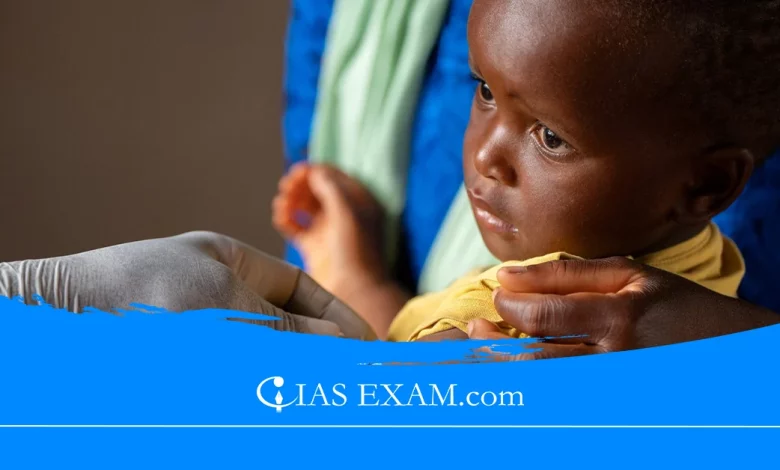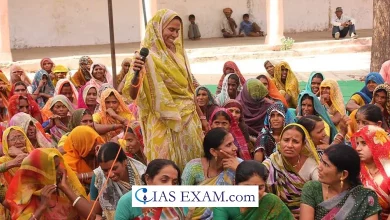Daily Current Affairs for UPSC
Global child deaths reached a historic low in 2022
Syllabus- Government Policies and Interventions [GS Paper-2]

Context
According to the latest estimates by the United Nations Inter-agency Group for Child Mortality Estimation, Global child deaths reached a historic low in 2022.
About
- The document mentioned the annual number of global under-five deaths in 2022 declined by more than half from the 2000 estimate — from 9.9 million to 4.9 million.
- However, the numbers are still terrible. Globally,
- neonatal deaths, or the death of an infant within 28 days of birth, took place every 14 seconds;
- a child aged under 5 died every 6 seconds and
- a child (ages 10 to 19) died each 35 seconds in 2022, the report found.
Major Highlights of the Report
- Decline in child deaths: The document stated a 62 percent decline in infant deaths from the 1990 estimates.
- However, it warned that “these averages mask persistent and entrenched inequities among vulnerable populations of childs.”
- Neonatal deaths: While the larger trend indicates a decline, the trend of under-five deaths has accelerated in the neonatal period from 41% in 2000 to 47% in 2022.
- The slower decline in neonatal deaths is because of factors like population change and differences in the cause-of-death structure by age.
- Mortality amongst 1-59 month-olds is normally more attentive to primary public health interventions, even as neonatal mortality relates more to complications around the time of birth.
- Sub-saharan Africa: Sub-Saharan Africa, in which annual neonatal deaths have stagnated at about 1 million, bears the highest burden of under-five deaths in the world.
- The mortality rate for children aged 28 days was 46 deaths per 1,000 children in the region, more than two times higher than the global average of 20 deaths per 1,000 children aged 28 days.
- Leading reasons: Prematurity, pneumonia, trauma, malaria and diarrhoea are the major reasons of death for newborns and children, all preventable causes.
- These diseases could have been prevented with vaccinations, availability of skilled health personnel at delivery, assistance for early and continued breastfeeding.
- Survival elements: The child’s survival largely depends on the place of birth; whether the child belongs to a low-income or high-income country, and additionally on the inequity within countries.
- On average, childs living in rural regions are at a higher chance of death before age 5 compared to their urban counterparts.
- Predictions: The report estimates that 35 million children beneath the age of 5 will lose their life before 2030 and sub-Saharan Africa will bear the most of the death toll.
- It similarly warned that under current tendencies, 59 countries will pass over the SDG under-five mortality goal and 64 countries will pass over the neonatal mortality target.
Child Mortality in India: Status and Trends
- As per the Sample Registration System (SRS) Statistical Report 2020 launched on 22nd September 2022 by Registrar General of India (RGI), the country has been witnessing a modern reduction in IMR, U5MR and NMR on account that 2014 in the direction of achieving the Sustainable Development Goals (SDG) objectives by 2030.
- Under five Mortality Rate (U5MR) for the country has proven a sizable decline of three factors from 2019 (32 per 1000 live births in 2020 in opposition to 35 per 1000 live births in 2019).
- It varies from 36 in rural areas to 21 in city areas and U5MR for women is higher (33) than male (31).
- Infant Mortality Rate (IMR) has additionally registered a 2-point decline to 28 per 1000 live births in 2020 from 30 per 1000 live births in 2019 (Annual Decline Rate: 6.7%).
- The Rural-Urban difference has narrowed to 12 points (Urban 19, Rural-31).
- Neonatal Mortality Rate has also declined with the aid of 2 factors from 22 per 1000 live births in 2019 to 20 per 1000 live births in 2020 (Annual Decline Rate: 9.1%).
- It tiers from 12 in urban areas to 23 in rural regions.
Major Causes of Child Mortality in India
- Preterm Birth Complications: Low birth weight, respiration issues due to underdeveloped lungs.
- Birth Asphyxia: Lack of oxygen during delivery, leading to brain damage or death.
- Neonatal Infections: Sepsis, pneumonia can overwhelm a newborn’s susceptible immune system.
- Pneumonia: The main reason, frequently due to malnutrition and air pollutants.
- Diarrhoea: Dehydration as a result of infectious sicknesses like rotavirus.
- Malnutrition: Stunting and wasting weaken a child’s immune system and increase vulnerability to infections.
Measures to Reduce Child Mortality
- Improving Maternal Health
-
-
- Prenatal Care: Regular checkups, proper nutrients for pregnant women to save you headaches and low birth weight.
- Skilled Birth Attendance: Deliveries with the aid of educated midwives or doctors to ensure safe childbirth.
- Postnatal Care: Monitoring the well-being of mothers and newborns after delivery.
-
- Combating Childhood Illnesses
-
-
- Immunization Programs: Ensure usual access to vaccinations for preventable diseases like measles, pneumonia, and diarrhea.
- Improved Sanitation and Hygiene: Promote handwashing with cleaning soap, access to clean drinking water, and proper sanitation facilities.
- Pneumonia Control: Early diagnosis and treatment with antibiotics.
- Diarrhoea Management: Oral rehydration remedy (ORT) with clean water and electrolytes to save from dehydration.
-
- Addressing Malnutrition
-
-
- Nutritional Programs: Promote breastfeeding for newborns, provide access to nutritious food for mothers and children, specially at some point of the crucial first 1000 days of life.
-
- Public Awareness
-
-
- Educate families: Importance of excellent hygiene, breastfeeding, timed medical care of children, and spotting danger signs of illness.
-
- Additional Measures
-
- Invest in Healthcare Infrastructure: Equip health facilities, especially in rural regions, with necessary supplies and train healthcare workers.
- Address Social Determinants: Poverty, lack of education, and gender inequality significantly make a contribution to child mortality.
- Empowering Women: Education and financial empowerment of women cause better health outcomes for themselves and their children.
Way Ahead
- By tackling causes behind the child mortality and implementing required measures, India can substantially reduce child mortality and ensure a healthier future for its young generation.
Source: The Down to Earth
UPSC Mains Practice Question
Q.Which of the following are the objectives of ‘National Nutrition Mission’? (2017)
- To create awareness relating to malnutrition among pregnant women and lactating mothers.
- To reduce the incidence of anaemia among young children, adolescent girls and women.
- To promote the consumption of millets, coarse cereals and unpolished rice.
- To promote the consumption of poultry eggs.
Select the correct answer using the code given below:
a. 1 and 2 only b. 1, 2 and 3 only
c. 1, 2 and 4 only d. 3 and 4 only
Ans – “a”





.png)



